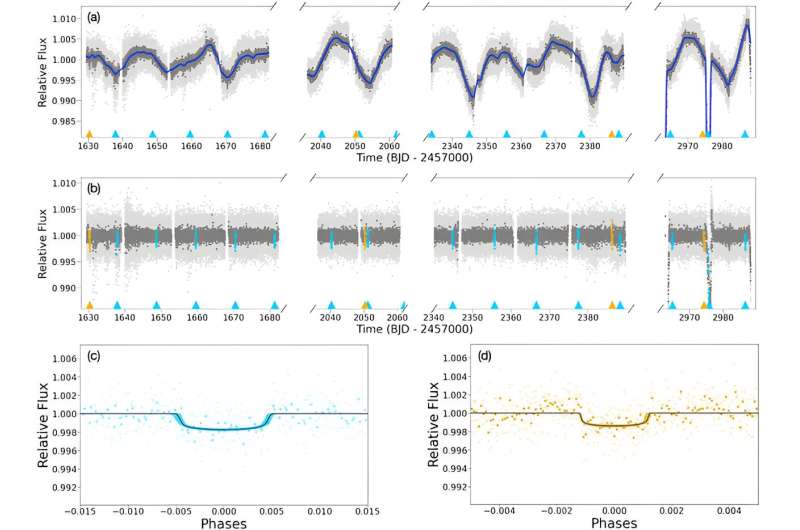January 16, 2024 feature
This article has been reviewed according to Science X's editorial process and policies. Editors have highlighted the following attributes while ensuring the content's credibility:
fact-checked
peer-reviewed publication
trusted source
proofread
Twins or cousins? Sub-Neptune exoplanets could provide an answer

Astronomers have discovered a pair of exoplanets orbiting an M dwarf star, one of which is the coldest M dwarf planet found by the TESS satellite observatory, making it accessible for follow-up studies of its atmosphere. The work is published in The Astrophysical Journal Letters.
The planets orbit the star TOI 904, which is 150 light years from Earth, and are both sub-Neptunes, with radii over two times that of Earth, but smaller than Neptune. Discovered with the Transiting Exoplanet Survey Satellite (TESS), the outer planet, TOI 904c, takes 84 days to circle its star and has an estimated equilibrium temperature of 217 K (-56°C), the coldest M dwarf planet discovered by TESS to date.
Its companion, TOI 904b, orbits the star every 11 days. The host star is bright enough in the infrared to allow future determinations of the exoplanet masses and characteristics of their atmospheres, but cool and dim enough that the star's luminosity does not overwhelm observing telescopes.
TESS is a satellite designed to study exoplanets around the brightest dwarf stars. Its original two-year mission ended in July 2020, but it has been extended twice and is still collecting data on the brightness of thousands of stars. As exoplanets orbit a star, astronomers look for small, periodic declines in its intensity as the planets pass, or transit, between TESS and the star.
The data collected by TESS is under very active investigation and reveals that about 75% of stars found were M dwarfs, both smaller and dimmer than the sun, and to date it has found over 7,000 candidate exoplanets, with over 400 now confirmed.
NASA's earlier Kepler mission, which lasted four years and ended in 2013, found three exoplanets with comparable orbital periods but orbiting dimmer host stars. Because an exoplanet's atmosphere is studied by observing changes in the host star's spectrum as its light passes through the thin outer shell of the exoplanet, a brighter star, like TOI 904 here, provides a better ground-based opportunity to identify changes that characterize the atmosphere's chemical composition, such as water vapor, oxygen, ozone and carbon dioxide.
In this study, the exoplanets are of similar size (2.5 and 2.3 Earth radii, respectively) and orbit their star at distances of 0.06 and 0.31 au (astronomical units, the average distance from the sun to the Earth), with a relatively wide separation between them.
Kepler discovered only about 30 planets at distances greater than 0.15 au, corresponding to periods greater than 25 days. So, the current study will offer a window into an unexplored region of such exoplanets and provide targets for future studies.
Unlike the three earlier exoplanets discovered by Kepler, this star is bright enough to provide a unique opportunity (so far) to determine the planetary masses as well, determining their average densities. Such knowledge would begin to constrain the composition of both planets in this system; similar densities would suggest they have similar formation histories, or else they evolved through different means while orbiting the same star.
The group looked for variations in the transit times of planets b and c, which could indicate the presence of non-transiting exoplanets around the same star, but found no evidence of additional planets in the system.
Exoplanets around M dwarf stars are of particular interest due to the long lifetimes of such stellar objects, especially those in the star's habitable zone. Type M dwarf stars, also called red dwarfs, are the coolest of the various types of dwarf stars and are easily the most common type of star in the sun's neighborhood, and probably the Milky Way galaxy where they comprise up to 75% of all stars. The nearest star to Earth, Proxima Centauri, is an M dwarf.
These stars have radii less than half of the sun's, with a surface temperature between 2700 K and 4000 K (compared to the sun's 5700 K). This means their habitable zones, where liquid surface water could allow life as we know it to exist, are close to the star, typically about 0.2 au (astronomical units, where the Earth-sun distance is 1 au).
Neither of the exoplanets orbiting TOI 904 are in the star's habitable zone, with "b" being too close (so any water would have evaporated away) and "c" being too far, so any water and other compounds there, if they exist, would be frozen.
"The differences and similarities in the compositions of these two planets can give us an idea of when and where they formed around their host star," said Mallory Harris, a Ph.D. candidate at the University of New Mexico who is the study's lead author. "This could tell us more about how planets form around M dwarf stars in general."
More information: Mallory Harris et al, Separated Twins or Just Siblings? A Multiplanet System around an M Dwarf Including a Cool Sub-Neptune, The Astrophysical Journal Letters (2023). DOI: 10.3847/2041-8213/ad037d
Journal information: Astrophysical Journal Letters
© 2024 Science X Network





















